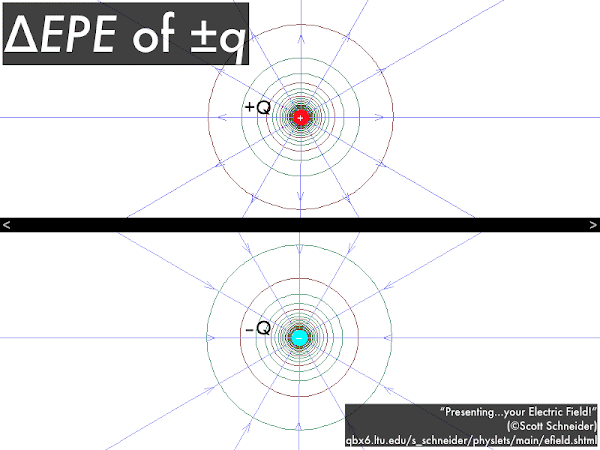Cuesta College, San Luis Obispo, CA
Students have a bi-weekly online reading assignment (hosted by SurveyMonkey.com), where they answer questions based on reading their textbook, material covered in previous lectures, opinion questions, and/or asking (anonymous) questions or making (anonymous) comments. Full credit is given for completing the online reading assignment before next week's lecture, regardless if whether their answers are correct/incorrect. Selected results/questions/comments are addressed by the instructor at the start of the following lecture.
The following questions were asked on reading textbook chapters and previewing presentations on electric potential energy.

Selected/edited responses are given below.
Describe what you understand from the assigned textbook reading or presentation preview. Your description (2-3 sentences) should specifically demonstrate your level of understanding.
"EPE is equal to the k constant times the source charge q1 times the test charge q1divided by a distance denoted as r. Voltage (potential) is equal to the k constant times the source charge Q divided by a distance from the source charge r."Describe what you found confusing from the assigned textbook reading or presentation preview. Your description (2-3 sentences) should specifically identify the concept(s) that you do not understand.
"Electric potential energy can change when moving a source charge and test charge closer together, or moving them farther apart. One direction will give a positive change in EPE when pushing like signs together or pulling two opposite signs apart."
"Electric potential energy can be increased by pushing together like-sign charges or pulling apart opposite-sign charges. This results in a change in electric potential energy because it requires work to be done. Work is done by charges that are allowed to do what they want."
"I understood EPE can be increased by pushing like charges together or pulling apart opposite charges. While, allowing things to act without using 'work' results in a decreased EPE. Also, I believe to calculate ∆EPE, one must calculate the EPE at different locations and subtract."
"EPE utilizes a field of equipotentials, similar to electric fields."
"I get there is a difference between electric potential energy and electric potential, but I don’t really know what it is."
"Maybe the images on the blog explaining when something was negative rather than positive."Explain the difference between the units of electric potential V, and electric potential energy, EPE.
"I did not understand voltage, electric potential energy and what the peaks or wells mean."
"The difference between electric potential and electric potential energy is a bit confusing. I'm also getting lost on how the two-step approach is implemented in finding the potential energy."
"I had a hard time with the end of the presentation because I was confused about the circular equipotentials. Also, are EPE and potential are the same? I don't know why they have different labels in the equations."
"I am a little unclear with how to determine when something is a two-step approach versus a direct approach."
"The textbook does not have good examples of these types of problem. Can you please go over in class?"
"Nothing at this time. Possibly application."
"EPE is in joules and potential is in joules per coulombs."
"The electric potential energy is an energy and is measured in joules. The electric potential is an energy per unit charge and is measured in joules per coulomb, or volts."
"The units."
"I don't understand the difference in units for the different energy potentials."
Explain the conceptual difference between the electric potential V, and electric potential energy, EPE.
"EPE is measured in joules because it is an energy. The volt is measured in joules per unit."
"Electric potential energy is an energy while electric potential is an energy per unit charge."
"Electric potential is created by a source charge. EPE is the energy stored in electric potential. I think this is why I'm so confused. I get one is an energy and the other one is an energy per charge but I don’t get how they relate to each other, or if one created the other..."
"Not really sure."
Briefly summarize the difference (if any) between "voltage" and electric potential.
"They are the same."
"A volt is the way to measure electric potential."
"There isn't a difference. Electric potential is measured in volts at a location in space."
"They are interchangeable."

Identify the changes in electric potential energy EPE (if any) for the following test charges (±q):
(Only correct responses shown.)
Positive test charge +q brought closer to a positive source charge +Q: increase [67%]
Negative test charge –q brought closer to a positive source charge +Q: decrease [70%]
Positive test charge +q brought closer to a negative source charge –Q: decrease [70%]
Negative test charge –q brought closer to a negative source charge –Q: increase [73%]
Identify the changes in electric potential V (if any) for the following test charges (±q):
(Only correct responses shown.)
Positive test charge +q brought closer to a positive source charge +Q: increase [48%]
Negative test charge –q brought closer to a positive source charge +Q: increase [48%]
Positive test charge +q brought closer to a negative source charge –Q: decrease [42%]
Negative test charge –q brought closer to a negative source charge –Q: decrease [45%]
Ask the instructor an anonymous question, or make a comment. Selected questions/comments may be discussed in class.
"Pleeeeease review the difference of potential and EPE."
"Thrilled to see the energy equation back with a new member added to it."
"That was electrifying."
"I am having a hard time with the last question, are you going to go over it in class?"
"Would like to review the last question above."
"You weren't lying when you said this material was THICK."
"Do the concepts in this section relate to how magnets work? (Not yet. Too soon.)
No comments:
Post a Comment